传感器英文课件
传感器(sensor)英文PPT演讲课件
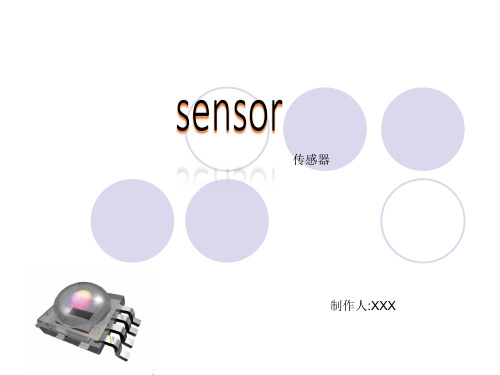
Aplication
A. the sensor does not need to check it agision. General Hall current sensor module’s precision in the work area is higher than 1%, and the precis ion is suitable for any waveform meas urement;
翻译
定义: 能感受规定的被测量并按照一定的 规律转换成可 用输出信号的器件或装置。 作用:
探测、感受外界的信号、物理条件(如光、 热、 湿度)或化学组成(如烟雾),并将 探知的信息传递给 其他装置或器官。
Light sensor
Light sensor is the most current production, one of the most widely used sensors, it plays
Working principle
Light sensors can converts light signals into electrical signals with photosensitive element sensor , its sensitive wavelengths is close to the visible light wavelength, including infrared wavelengthand ultraviolet wavelengths. Light sensor is not limited to light detection, it also can be used as a detection device of other sensors to test many non-electrical, as long as the nonelectric can be converted into optical signal changes.
传感器中英文介绍

传感器中英文介绍(总5页) -CAL-FENGHAI.-(YICAI)-Company One1-CAL-本页仅作为文档封面,使用请直接删除. sensorssensors(English name: transducer/sensor) is a kind of detection device, can feel the measured information, and will feel information transformation according to certain rule become electrical signal output, or other form of information needed to satisfy theinformation transmission, processing, storage, display, record and control requirements.Sensor's features include: miniaturization, digital, intelligent, multi-functional, systematic and network. It is the first step of automatic detection and automatic control. The existence and development of the sensor, let objects have sensory, such as touch, taste and smell let objects become live up slowly. Usually accordingto its basic cognitive functions are divided into temperature sensor, light sensor, gas sensor, force sensor, magnetic sensor, moisture sensor, acoustic sensor, radiation sensitive element, color sensorand sensor etc. 10 major categories.temperature transducerTemperature sensors (temperature transducer) refers to can feel temperature translates into usable output signal of the sensor. The temperature sensor is the core part of the temperature measuring instrument, wide variety. According to measuring methods could be divided into two types: contact and non-contact, according to the sensor material and electronic component features divided into two categories, thermal resistance and thermocouple.1 principle of thermocoupleThermocouple is composed of two different materials of metal wire, the welded together at the end. To measure the heating part of the environment temperature, can accurately know the temperature of the hot spots. Because it must have two different material of the conductor, so called the thermocouple. Different material to make the thermocouple used in different temperature range, their sensitivityis also each are not identical. The sensitivity of thermocouplerefers to add 1 ℃ hot spot temperature changes, the output variation of potential difference. For most of the metal material supportther mocouple, this value about between 5 ~ 40 microvolt / ℃.As a result of the thermocouple temperature sensor sensitivityhas nothing to do with the thickness of material, use very fine material also can make the temperature sensor. Also due to the production of thermocouple metal materials have good ductility, the slight temperature measuring element has high response speed, can measure the process of rapid change.Its advantages are:(1)high precision measurement. Because of thermocouple direct contact with the object being measured, not affected by intermediate medium.(2)the measurement range. Commonly used thermocouple from1600 ℃ to 50 ℃ ~ + sustainable measurement, some special thermocouple minimum measurable to - 269 ℃ (e.g., gold iron nickel chrome), the h ighest measurable to + 2800 ℃ (such as tungsten rhenium).(3) simple structure, easy to use. Thermocouple is usually composed of two different kinds of metal wire, but is not limited by the size and the beginning of, outside has protective casing, so very convenient to use. The thermocouple type and structure of the form.2. The thermocouple type and structure formation(1)the types of thermocoupleThe commonly used thermocouple could be divided into two types: standard thermocouple and non-standard thermocouple. Standard thermocouple refers to the national standard specifies its thermoelectric potential and the relationship between temperature, permissible error, and a unified standard score table of thermocouple, it has with matching display instrument to choose from. Rather than a standard thermocouple or on the order of magnitude less than therange to use standardized thermocouple, in general, there is no uniform standard, it is mainly used for measurement of some special occasions.Standardized thermocouple is our country from January 1, 1988, thermocouple and thermal resistance of all production according toIEC international standard, and specify the S, B, E, K, R, J, T sevenstandardization thermocouple type thermocouple for our countryunified design.(2)to ensure that the thermocouple is reliable, steady work, the structure of thermocouple requirements are as follows:①of the two thermocouple thermal electrode welding must be strong;②two hot electrode should be well insulated between each other, in case of short circuit;③compensation wires connected to the free cod of a thermocouple to convenient and reliable;④protect casing thermal electrodes should be able to make sufficient isolation and harmful medium.3.The thermocouple cold end temperature compensationDue to the thermocouple materials are generally more expensive (especially when using precious metals), and the temperature measurement points are generally more far, the distance to the instrument in order to save materials, reduce cost, usually adopt the compensating conductor) (the free end of the cold junction of the thermocouple to the steady control of indoor temperature, connectedto the meter terminals. It must be pointed out that the role of the thermocouple compensation wire extension hot electrode, so that only moved to the control room of the cold junction of the thermocouple instrument on the terminal, it itself does not eliminate the cold end temperature change on the influence of temperature, cannot have the compensation effect. So, still need to take some of the other correction method to compensate of the cold end temperatureespecially when t0 indicates influence on measuring temperature 0 ℃.Must pay attention to when using thermocouple compensating conductor model match, cannot be wrong polarity, compensation conductor should be connected to the thermocouple temperature should not exceed 100 ℃.传感器传感器(英文名称:transducer/sensor)是一种检测装置,能感受到被测量的信息,并能将感受到的信息,按一定规律变换成为电信号或其他所需形式的信息输出,以满足信息的传输、处理、存储、显示、记录和控制等要求。
传感器中英文介绍
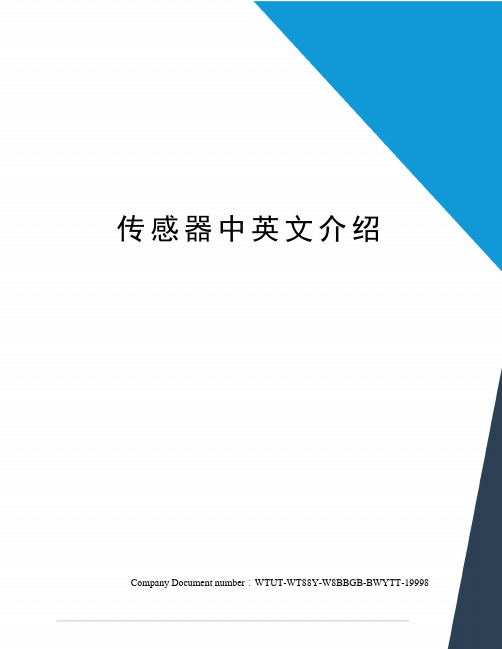
传感器中英文介绍Company Document number:WTUT-WT88Y-W8BBGB-BWYTT-19998. sensorssensors(English name: transducer/sensor) is a kind of detection device, can feel the measured information, and will feel information transformation according to certain rule become electrical signal output, or other form of information needed to satisfy the information transmission, processing, storage, display, record and control requirements.Sensor's features include: miniaturization, digital, intelligent, multi-functional, systematic and network. It is the first step of automatic detection and automatic control. The existence and development of the sensor, let objects have sensory, such as touch, taste and smell let objects become live up slowly. Usually according to its basic cognitive functions are divided into temperature sensor, light sensor, gas sensor, force sensor, magnetic sensor, moisture sensor, acoustic sensor, radiation sensitive element, color sensor and sensor etc. 10 major categories.temperature transducerTemperature sensors (temperature transducer) refers to can feel temperature translates into usable output signal of the sensor. The temperature sensor is the core part of the temperature measuring instrument, wide variety. According to measuring methods could be divided into two types: contact and non-contact, according to the sensor material and electronic component features divided into two categories, thermal resistance and thermocouple.1 principle of thermocoupleThermocouple is composed of two different materials of metal wire, the welded together at the end. To measure the heating part of the environment temperature, can accurately know the temperature of the hot spots. Because it must have two different material of the conductor, so called the thermocouple. Different material to make the thermocouple used in different temperature range, their sensitivity is also each are not identical. The sensitivity of thermocouple refers to add 1 ℃ hot spot temperature changes, the output variation of potential difference. For most of the metal material support thermocouple, this value about between 5 ~ 40 microvolt / ℃.As a result of the thermocouple temperature sensor sensitivity has nothing to do with the thickness of material, use very fine material also can make the temperature sensor. Also due to the production of thermocouple metal materials have good ductility, the slight temperature measuring element has high response speed, can measure the process of rapid change.Its advantages are:(1)high precision measurement. Because of thermocouple direct contact with the object being measured, not affected by intermediate medium.(2)the measurement range. Commonly used thermocouple from 1600 ℃ to50 ℃ ~ + sustainable measurement, some special thermocouple minimum measurable to - 269 ℃ ., gold iron nickel chrome), the highest measurable to + 2800 ℃ (such as tungsten rhenium).(3) simple structure, easy to use. Thermocouple is usually composed of two different kinds of metal wire, but is not limited by the size and the beginning of, outside has protective casing, so very convenient to use. The thermocouple type and structure of the form.2. The thermocouple type and structure formation(1)the types of thermocoupleThe commonly used thermocouple could be divided into two types: standard thermocouple and non-standard thermocouple. Standard thermocouple refers to the national standard specifies its thermoelectric potential and the relationship between temperature, permissible error, and a unified standard score table of thermocouple, it has with matching display instrument to choose from. Rather than a standard thermocouple or on the order of magnitude less than the range to use standardized thermocouple, in general, there is no uniform standard, it is mainly used for measurement of some special occasions.Standardized thermocouple is our country from January 1, 1988, thermocouple and thermal resistance of all production according to IEC international standard, and specify the S, B, E, K, R, J, T seven standardization thermocouple type thermocouple for our country unified design.(2)to ensure that the thermocouple is reliable, steady work, the structure of thermocouple requirements are as follows:①of the two thermocouple thermal electrode welding must be strong;②two hot electrode should be well insulated between each other, in case of short circuit;③compensation wires connected to the free cod of a thermocouple to convenient and reliable;④protect casing thermal electrodes should be able to make sufficient isolation and harmful medium.3.The thermocouple cold end temperature compensationDue to the thermocouple materials are generally more expensive (especially when using precious metals), and the temperature measurement points are generally more far, the distance to the instrument in order to save materials, reduce cost, usually adopt the compensating conductor) (the free end of the cold junction of the thermocouple to the steady control of indoor temperature, connected to the meter terminals. It must be pointed out that the role of the thermocouple compensation wire extension hot electrode, so that only moved to the control room of the cold junction of the thermocouple instrument on the terminal, it itself does not eliminate the cold end temperature change on the influence of temperature, cannot have the compensation effect. So, still need to take some of the other correction method to compensate of the cold end temperature especially when t0 indicates influence on measuring temperature 0 ℃.Must pay attention to when using thermocouple compensating conductor model match, cannot be wrong polarity, compensation conductor should be connected to the thermocouple temperature should not exceed 100 ℃.传感器传感器(名称:transducer/sensor)是一种检测装置,能感受到被测量的信息,并能将感受到的信息,按一定规律变换成为电信号或其他所需形式的信息输出,以满足信息的传输、处理、存储、显示、记录和控制等要求。
Temperature sensor 温度传感器PPT英文
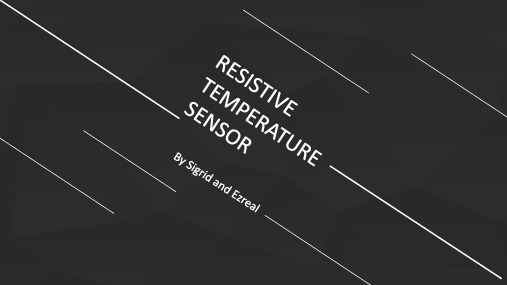
2
~
Transduction and Signal Conditioning
ENTER TEXT
E
Ra Us
Rb
Rw S
r1 Rt A
r2
How does it Works?
How does it Works?
1
2
3
4
Types
Platinum RTDs
Secondary SPRTs
ENTER TEXT
Platinum resistance thermometers (PRTs).
SPRTs
They are constructed like the SPRT, but the materials are more cost-effective. The highest accuracy of all PRTs.
Components
Components
Sensing element
Protective housing
Lead wires
Components--Sensing Element
Hale Waihona Puke 11Strain Free Elements
2 3
2
Wire coil wound elements (or coil-in-thehole elements)
Datasheet
材料 温度系数 (1/℃) 3.92× 10-3 ( 比电阻 · mm2/m 0.0981 ) 温度范围 (℃) 特性
铂
-200 ~ +650
近线性
铜
4.25×10-3
0.0170
-50 ~ +150
传感器英文含义
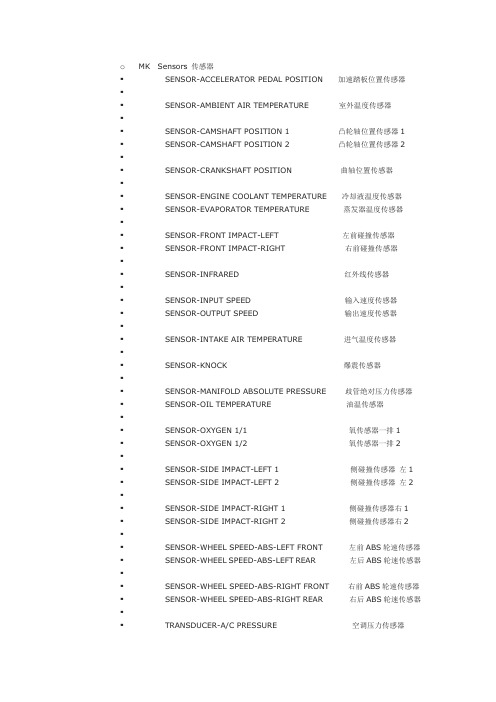
o MK Sensors 传感器▪SENSOR-ACCELERATOR PEDAL POSITION 加速踏板位置传感器▪▪SENSOR-AMBIENT AIR TEMPERATURE 室外温度传感器▪▪SENSOR-CAMSHAFT POSITION 1 凸轮轴位置传感器1▪SENSOR-CAMSHAFT POSITION 2 凸轮轴位置传感器2▪▪SENSOR-CRANKSHAFT POSITION 曲轴位置传感器▪▪SENSOR-ENGINE COOLANT TEMPERATURE 冷却液温度传感器▪SENSOR-EVAPORATOR TEMPERATURE 蒸发器温度传感器▪▪SENSOR-FRONT IMPACT-LEFT 左前碰撞传感器▪SENSOR-FRONT IMPACT-RIGHT 右前碰撞传感器▪▪SENSOR-INFRARED 红外线传感器▪▪SENSOR-INPUT SPEED 输入速度传感器▪SENSOR-OUTPUT SPEED 输出速度传感器▪▪SENSOR-INTAKE AIR TEMPERATURE 进气温度传感器▪▪SENSOR-KNOCK 爆震传感器▪▪SENSOR-MANIFOLD ABSOLUTE PRESSURE 歧管绝对压力传感器▪SENSOR-OIL TEMPERATURE 油温传感器▪▪SENSOR-OXYGEN 1/1 氧传感器一排1▪SENSOR-OXYGEN 1/2 氧传感器一排2▪▪SENSOR-SIDE IMPACT-LEFT 1 侧碰撞传感器左1 ▪SENSOR-SIDE IMPACT-LEFT 2 侧碰撞传感器左2 ▪▪SENSOR-SIDE IMPACT-RIGHT 1 侧碰撞传感器右1 ▪SENSOR-SIDE IMPACT-RIGHT 2 侧碰撞传感器右2 ▪▪SENSOR-WHEEL SPEED-ABS-LEFT FRONT 左前ABS轮速传感器▪SENSOR-WHEEL SPEED-ABS-LEFT REAR 左后ABS轮速传感器▪▪SENSOR-WHEEL SPEED-ABS-RIGHT FRONT 右前ABS轮速传感器▪SENSOR-WHEEL SPEED-ABS-RIGHT REAR 右后ABS轮速传感器▪▪TRANSDUCER-A/C PRESSURE 空调压力传感器。
温度传感器演示稿-英文
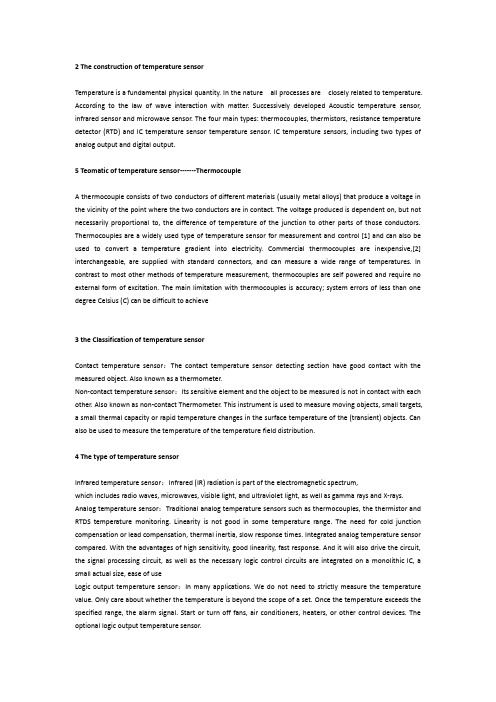
2 The construction of temperature sensorTemperature is a fundamental physical quantity. In the nature all processes are closely related to temperature. According to the law of wave interaction with matter. Successively developed Acoustic temperature sensor, infrared sensor and microwave sensor. The four main types: thermocouples, thermistors, resistance temperature detector (RTD) and IC temperature sensor temperature sensor. IC temperature sensors, including two types of analog output and digital output.5 Teomatic of temperature sensor-------ThermocoupleA thermocouple consists of two conductors of different materials (usually metal alloys) that produce a voltage in the vicinity of the point where the two conductors are in contact. The voltage produced is dependent on, but not necessarily proportional to, the difference of temperature of the junction to other parts of those conductors. Thermocouples are a widely used type of temperature sensor for measurement and control [1] and can also be used to convert a temperature gradient into electricity. Commercial thermocouples are inexpensive,[2] interchangeable, are supplied with standard connectors, and can measure a wide range of temperatures. In contrast to most other methods of temperature measurement, thermocouples are self powered and require no external form of excitation. The main limitation with thermocouples is accuracy; system errors of less than one degree Celsius (C) can be difficult to achieve3 the Classification of temperature sensorContact temperature sensor:The contact temperature sensor detecting section have good contact with the measured object. Also known as a thermometer.Non-contact temperature sensor:Its sensitive element and the object to be measured is not in contact with each other. Also known as non-contact Thermometer. This instrument is used to measure moving objects, small targets, a small thermal capacity or rapid temperature changes in the surface temperature of the (transient) objects. Can also be used to measure the temperature of the temperature field distribution.4 The type of temperature sensorInfrared temperature sensor:Infrared (IR) radiation is part of the electromagnetic spectrum,which includes radio waves, microwaves, visible light, and ultraviolet light, as well as gamma rays and X-rays. Analog temperature sensor:Traditional analog temperature sensors such as thermocouples, the thermistor and RTDS temperature monitoring. Linearity is not good in some temperature range. The need for cold junction compensation or lead compensation, thermal inertia, slow response times. Integrated analog temperature sensor compared. With the advantages of high sensitivity, good linearity, fast response. And it will also drive the circuit, the signal processing circuit, as well as the necessary logic control circuits are integrated on a monolithic IC, a small actual size, ease of useLogic output temperature sensor:In many applications. We do not need to strictly measure the temperature value. Only care about whether the temperature is beyond the scope of a set. Once the temperature exceeds the specified range, the alarm signal. Start or turn off fans, air conditioners, heaters, or other control devices. The optional logic output temperature sensor.6 select the right temperature sensorIf you want to make reliable temperature measurements. First you need to select the correct temperature meter. Also is a temperature sensor. The thermocouples, thermistors, platinum resistance (RTD), and the temperature IC is the most commonly used temperature sensor in the test.Thermocouples are the simplest and most common temperature sensor. But the thermocouple is not suitable for high-precision measurement applications.The Thermistor have its measurement techniques. The size of thermistor is small. Can stabilize soon, will not cause the heat load. But it is fragile. If Large current across will cause self-heating. The thermistor is a resistive device. Any current source will power on fever. Power is equal to the square of the current resistance plot. So to use a small current source. If the thermistor is exposed in the heat. Will lead to permanent damage.7 Development trendsAfter entering the 21st century. Smart temperature sensor is moving in high-precision, multi-function bus standardization, high reliability and security, the development of a virtual sensor and network sensor developed single-chip temperature measurement system and other high-tech direction rapidly. Smart temperature sensor bus technology to achieve standardization and normalization. Single line (1-Wire) bus, I2C bus, SMBus bus and spI bus in the bus. Temperature sensor as a slave by the dedicated bus interface with the host communications.。
传感器中英文介绍
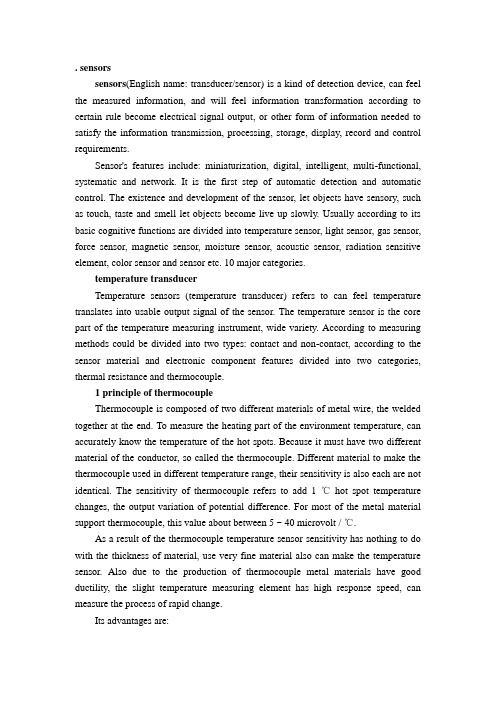
. sensorssensors(English name: transducer/sensor) is a kind of detection device, can feel the measured information, and will feel information transformation according to certain rule become electrical signal output, or other form of information needed to satisfy the information transmission, processing, storage, display, record and control requirements.Sensor's features include: miniaturization, digital, intelligent, multi-functional, systematic and network. It is the first step of automatic detection and automatic control. The existence and development of the sensor, let objects have sensory, such as touch, taste and smell let objects become live up slowly. Usually according to its basic cognitive functions are divided into temperature sensor, light sensor, gas sensor, force sensor, magnetic sensor, moisture sensor, acoustic sensor, radiation sensitive element, color sensor and sensor etc. 10 major categories.temperature transducerTemperature sensors (temperature transducer) refers to can feel temperature translates into usable output signal of the sensor. The temperature sensor is the core part of the temperature measuring instrument, wide variety. According to measuring methods could be divided into two types: contact and non-contact, according to the sensor material and electronic component features divided into two categories, thermal resistance and thermocouple.1 principle of thermocoupleThermocouple is composed of two different materials of metal wire, the welded together at the end. To measure the heating part of the environment temperature, can accurately know the temperature of the hot spots. Because it must have two different material of the conductor, so called the thermocouple. Different material to make the thermocouple used in different temperature range, their sensitivity is also each are not identical. The sensitivity of thermocouple refers to add 1 ℃hot spot temperature changes, the output variation of potential difference. For most of the metal material support thermocouple, this value about between 5 ~ 40 microvolt / ℃.As a result of the thermocouple temperature sensor sensitivity has nothing to do with the thickness of material, use very fine material also can make the temperature sensor. Also due to the production of thermocouple metal materials have good ductility, the slight temperature measuring element has high response speed, can measure the process of rapid change.Its advantages are:(1)high precision measurement. Because of thermocouple direct contact with the object being measured, not affected by intermediate medium.(2)the measurement range. Commonly used thermocouple from 1600 ℃to 50 ℃ ~ + sustainable measurement, some special thermocouple minimum measurable to - 269 ℃ (e.g., gold iron nickel chrome), the highest measurable to + 2800 ℃ (such as tungsten rhenium).(3) simple structure, easy to use. Thermocouple is usually composed of two different kinds of metal wire, but is not limited by the size and the beginning of, outside has protective casing, so very convenient to use. The thermocouple type and structure of the form.2. The thermocouple type and structure formation(1)the types of thermocoupleThe commonly used thermocouple could be divided into two types: standard thermocouple and non-standard thermocouple. Standard thermocouple refers to the national standard specifies its thermoelectric potential and the relationship between temperature, permissible error, and a unified standard score table of thermocouple, it has with matching display instrument to choose from. Rather than a standard thermocouple or on the order of magnitude less than the range to use standardized thermocouple, in general, there is no uniform standard, it is mainly used for measurement of some special occasions.Standardized thermocouple is our country from January 1, 1988, thermocouple and thermal resistance of all production according to IEC international standard, and specify the S, B, E, K, R, J, T seven standardization thermocouple type thermocouple for our country unified design.(2)to ensure that the thermocouple is reliable, steady work, the structure of thermocouple requirements are as follows:①of the two thermocouple thermal electrode welding must be strong;②two hot electrode should be well insulated between each other, in case of short circuit;③compensation wires connected to the free cod of a thermocouple to convenient and reliable;④protect casing thermal electrodes should be able to make sufficient isolation and harmful medium.3.The thermocouple cold end temperature compensationDue to the thermocouple materials are generally more expensive (especiallywhen using precious metals), and the temperature measurement points are generally more far, the distance to the instrument in order to save materials, reduce cost, usually adopt the compensating conductor) (the free end of the cold junction of the thermocouple to the steady control of indoor temperature, connected to the meter terminals. It must be pointed out that the role of the thermocouple compensation wire extension hot electrode, so that only moved to the control room of the cold junction of the thermocouple instrument on the terminal, it itself does not eliminate the cold end temperature change on the influence of temperature, cannot have the compensation effect. So, still need to take some of the other correction method to compensate of the cold end temperature especially when t0 indicates influence on measuring temperature 0 ℃.Must pay attention to when using thermocouple compensating conductor model match, cannot be wrong polarity, compensation conductor should be connected to the thermocouple temperature should not exceed 100 ℃.传感器传感器(英文名称:transducer/sensor)是一种检测装置,能感受到被测量的信息,并能将感受到的信息,按一定规律变换成为电信号或其他所需形式的信息输出,以满足信息的传输、处理、存储、显示、记录和控制等要求。
霍尔传感器原理--中英双语PPT课件
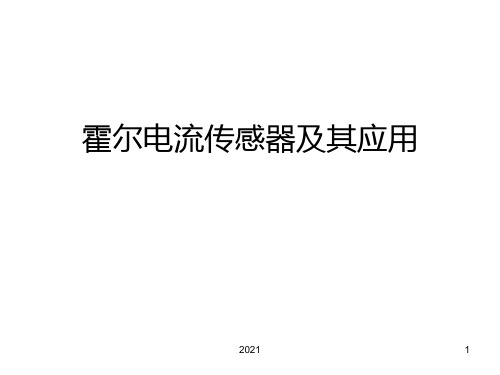
2021
6
霍尔电流传感器及其应用
开环电流传感器的原理图 open loop current sensor principle diagram
• ● The linearity is better than 0.5%; • ● Good dynamic performance. The dynamic
response time of general Hall sensor module is less than 7μs, and the tracking speed di/dt is above 50A/μs;
• The performance characteristics of Hall current sensor
• ● Measure the arbitrary waveform current, such as DC, AC, and even to transient peak parameters measurement;
动态响应时间小于为7μs,跟踪速度di / dt是 上述50A/μs; • ●工作频段宽。它可以工作在频率范围从0到 20 KHZ非常好; • ●过载能力强。测量范围宽(0〜±10000A); • ●高可靠性。平均无故障工作是超过5×10000 小时; • ●体积小,重量轻,易于安装和系统不会带来 任何损失
2021
5
霍尔电流传感器及其应用
• 霍尔电流传感器的性能特 性
• ●测量任意波形的电流,如DC,AC,乃至瞬 态峰值参数测量的;
传感器英文课件第1章-basic knowledge
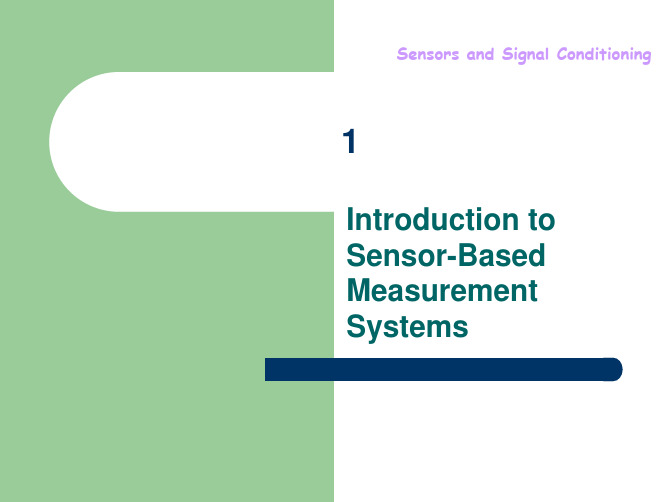
Transducers, Sensors, and Actuators
Transducer: converts a signal from one physical form to a corresponding signal having a different physical form “energy converter” (mechanical, thermal, magnetic, electric, chemical, and radiation) Sensor: offering an electric output A sensor may not be a transducer. modifier Input transducers (physical signal/electric signal) are termed sensors, or detectors for radiation, output transducers (electric signal/display or actuation) are termed actuators or effectors.
–
–
12
1.4 Static aracteristics of Measurement Systems
Accuracy, Precision, and Sensitivity
Accuracy is the quality that characterizes the capacity of a measuring instrument for giving results close to the true value of the measured quantity. Sensor accuracy is determined through static calibration. It consists of keeping constant all sensor inputs, except the one to be studied. Error: Any discrepancy between the true value for the measured quantity and the instrument reading. Absolute error: the difference between measurement result and the true value.
传感器英文课件第2章-resistive sensors
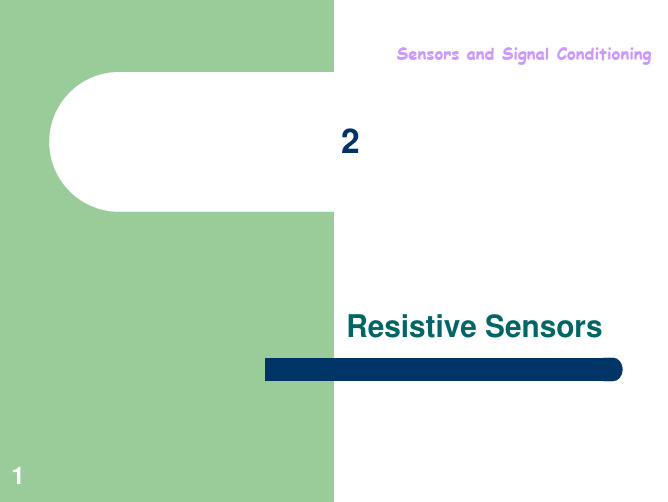
5
For (2.1) to be valid, if the potentiometer is supplied by an alternating voltage, its inductance and capacitance should be insignificant. For low values of the total resistance RT, the inductance may be significant, particularly in models with wound resistive elements. For high values of RT, the parasitic capacitance may be important. Furthermore, resistors drift with temperature. Temperature changes can arise not only from fluctuations in ambient temperature but also from selfheating due to the finite power that the potentiometer dissipates. Friction and inertia of the wiper also limit the model validity. Finally, noise associated with the wiper contact limits resolution.
Therefore for small variations, the resistance of the metallic wire is
13
14
When a semiconductor is stressed, in addition to its dimensional change, both the number of carriers and their average mobility change. Unlike metals,the resistivity change under stress dominates over the dimensional change.
传感器英文课件第3章-signal conditioning for resistive sensors

7
Methods for resistance measurement can be classified into deflection methods or null methods. Deflection methods sense the drop in voltage across the resistance to be measured or the current through it or both. Null methods are based on measurement bridges.
9
10
Once the balance condition has been achieved we have
That is, changes in R3 are directly proportional to the corresponding changes we have to produce in R4 in order to balance the bridge. This measurement method can be also used as a polarity detector because the output is positive or negative, depending on whether x is greater or less than a given threshold.
13
14
Figure 3.17(a):
Wires 1 and 3 must be equal and undergo the same temperature changes. The characteristics of wire 2 are irrelevant because in the balance condition there is no current through the bridge central arm.
《sensor传感器资料》课件

什么是传感器
定义和分类
传感器是一种能够感知和测量环境或物体特征的设备。根据测量的物理量和 工作原理,传感器可分为压力、温度、湿度、光照、加速度等不同类型。
传感器技术的发展趋势和前景展望
随着人工智能、物联网和大数据等技术的快速发展,传感器技术也在不断创 新,未来的发展趋势包括小型化、智能化和多功能化。
传感器在智能家居和物联网技术中发挥关键作用,用于实现环境监测、安全管理、能源管理和智能控制 等功能。
现代城市中传感器技术的应用
传感器技术在现代城市中有广泛应用,用于交通管理、环境监测、智慧城市建设等方面,提高城市的安 全性、便利性和可持续发展。
传感器的发展前景及趋势
传感器产业的发展历程和现状
传感器产业经过多年的发展已经取得了巨大的成就,但仍然面临挑战和机遇。 目前,传感器市场正不断扩大。
常见传感器的工作原理和应用
不同类型的传感器通过感知和转换环境中的物理量,如压力、温度和湿度等, 将其转化为电信号。常见应用包括环境监测、医疗设备、汽车、工业控制等 领域。
传感器的接口和输出
传感器的电气接口和信号输出
传感器的接口通常包括电源输入、信号输入和信号输出。电气接口的设计与传感器的工作原理和输出类 型密切相关。
常见传感器信号的特点和处理方法
传感器信号可能是模拟信号或数字信号,需要适当的信号处理方法将其转化为可用的数据。常见处理方 法包括放大、滤波、线性化等。
传感器的应用领域及相关技术
工业自动化领域的传感器应用
传感器在工业自动化领域中被广泛应用,用于监测和控制生产过程中的各种参数,提高生产效率和质量。
传感器英语

当这些设备部署在一个广泛的地理区域时,它们可以收集关于环 境的信息,并通过形成一个分布式通信网络,既无线传感器网络 (WSM)有效地协作处理这些信息,如图1.1所示。
A WSN is a special case of an ad-hoc wireless network, and assumes a multi-hop communication framework with no common infrastructure, where the sensors spontaneously cooperate to deliver information by forwarding packets from a source to a destination.
无线传感器网络
WIRELESS SENSOR NETWORKS
vocabulary
sensor
[ˈsensə(r)]
deploy
[dɪˈplɔɪ]
collaborate
[kəˈlæ bəreɪt]
illustrate
[ˈɪləstreɪt]
status
[ˈsteɪtəs]
传感器(sensor)英文PPT演讲课件

Acoustic sensors(声敏传感器)
Working principle
The sensor is sensitive to a built-in to sound capacitive [kə'pæsɪtɪv] electret microphone(电容式驻极话筒). Sound waves make the microphone electret film (驻极体膜) vibration [vaɪ'breɪʃ(ə)n], result in the change of capacitance [kə'pæsɪt(ə)ns], and produce with the corresponding change of tiny voltage ['vəʊltɪdʒ; 'vɒltɪdʒ]. Then this voltage is converted into 0 to 5 voltage, and transmitted to the computer, after A/D conversion was accepted by the data collector.
翻译
定义: 能感受规定的被测量并按照一定的 规律转换成可 用输出信号的器件或装置。 作用:
探测、感受外界的信号、物理条件(如光、 热、 湿度)或化学组成(如烟雾),并将 探知的信息传递给 其他装置或器官。
Light sensor
Light sensor is the most current production, one of the most widely used sensors, it plays an important role in automatic control(自动控 制) and non-electricity measurement [‘meʒəm(ə)nt] technology(非电量电测技 术). The simplest photosensitive sensor is photosensitive resistance(光敏电阻), it will create electric current when photons(光子) hit joint(结合处).
传感器 第二章
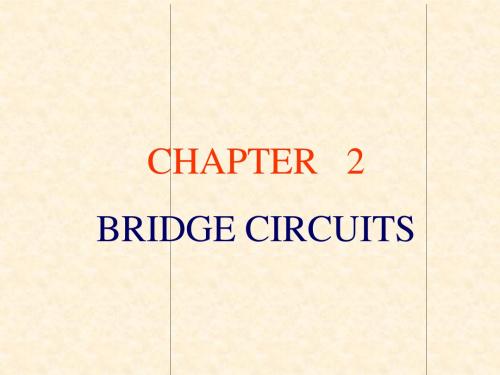
The all-element varying bridge produces the most signal for a given resistance change and is inherently linear. It is an industry-standard configuration for load cells which are constructed from four identical strain gages.
In some applications, the bridge nonlinearity may be acceptable, but there are various methods available to linearize bridges. Since there is a fixed relationship between the bridge resistance change and its output (show in the equations), software can be used to remove the linearity error in digital systems. Circuit techniques can also be used to linearize the bridge output directly, and these will be discussed shortly.
In many bridge applications there may be two,or even four elements which vary.
VB
VB
R R
R
R
R
VB
VB
各种传感器介绍ppt英文

Actuators & Sensors in Mechatronics: Introduction to Sensors
K. Craig 1
Types of Applications of Measurement Instrumentation
• Monitoring of Processes and Operations • Control of Processes and Operations • Experimental Engineering Analysis
Actuators & Sensors in Mechatronics: Introduction to Sensors K. Craig 6
• Note
– The distinction among monitoring, control, and analysis functions is not clear-cut; the category decided on may depend somewhat on your point of view and the apparent looseness of the classification should not cause any difficulty. – It is now extremely common for engineers to include in the design of a machine or process, as dedicated components, computers of various sizes. Computers are important, but the computer “component” of many machines and processes is often not the critical system element in terms of either technical or economic factors. Rather, components external to the computer, the actuators and sensors, are more often the limiting factors in the system design.
- 1、下载文档前请自行甄别文档内容的完整性,平台不提供额外的编辑、内容补充、找答案等附加服务。
- 2、"仅部分预览"的文档,不可在线预览部分如存在完整性等问题,可反馈申请退款(可完整预览的文档不适用该条件!)。
- 3、如文档侵犯您的权益,请联系客服反馈,我们会尽快为您处理(人工客服工作时间:9:00-18:30)。
Zhejiang University
Major Industry Players
Analog Devices Columbia Research Labs Capacitec EG&G ICSensors Endevco Humphrey Kistler Instruments Lucas Novasensor MTI Instruments Inc. PCB Piezotronic Quantum Research Group Raytek Sensors Magazine Silicon Designs Strain Measurement Devices Summit Instruments Thermometrics Vishay Intertechnology Yellow Springs Instruments
Heat capacity or mass Air speed/turbulence Limited by environmental disturbance
Audio background noise limits hearing capability
Broadband audio noise in jungle
Department of Optical Engineering
Zhejiang University
Pyroelectric Infrared Radial Sensor Product Description
Model: D203S
Encapsulation Type: TO-5 Window Size: 4× 3 mm2 Spectral Response: 5-14μm Output Signal [Vp-p]: ≥3300mV Sensitivity: ≥3100 V/W Detectivity (D*): 1. 4 × 108 cmHz1/2/W Noise [Vp-p]: <70mV Supply Voltage: 3-15V Operating Temp: -30-70ºC security systems, burglar alarms, visitor acknowledgement, light switch control and intellectualized toy, etc.
Future package 2 x 2 x 0.9 mm3 Operating condition:
power supplies 2.7 V consume only 450 μA can be power-cycled for even greater battery life The typical noise floor is 200 μg per rtHz, allowing small tilt changes to be sensed using the narrow bandwidths (<10 Hz) typical of human motion
Application:
Department of Optical Engineering
Zhejiang University
Introduction
What can modern sensors do?
Detect brain wave to control computer mouse (2006)…..
Zhejiang University
Industry’s Smallest Accelerometer
Size: 4 x 4 x 1.45 mm3 Manufacture: Analog Device
ADXL32x family of iMEMS (integrated micro electro mechanical system) accelerometers
The stimulus is the quantity, property, or condition that is sensed and converted into electrical signal.
The purpose of a sensor is to respond to some kind of an input physical property (stimulus) and to convert it into an electrical signal which is compatible with electronic circuits.
We may say that a sensor is a translator of a generally non-electrical value into an electrical value.
Department of Optical Engineering
Zhejiang University
What can modern sensors do?
Detect 2,4,6-trichloroanisole (TCA) in wine aroma at partper-trillion levels in seconds (10-12) (Znose by Electronic Sensor Technology)
Department of Optical Engineering
Zhejiang University
Sensor: A Definition
Байду номын сангаас
A sensor is a device that receives a stimulus and responds with an electrical signal. (maybe optical in near future) The term stimulus :
Department of Optical Engineering
Zhejiang University
Introduction
Modern Sensors are penetrating into our life:
Medical: Angioplasty, Infusion Pumps, Blood Pressure, Kidney Dialysis, Respiratory Automotive: Tire Pressure, MAP, Fuel and Engine Control Systems, Barometric Industrial: Portable Gauges, Manometers, Altitude Measurements, Barometry, Water Depth Consumer: iphone, ipad,…ieverything
Today
Department of Optical Engineering
Zhejiang University
Accelerometers
What can modern sensors do?
Miniature Accelerometer, Coloumbia Research Lab
Detect linear acceleration with high precision for industrial and military applications
Sensor head - Big size More work needs to be done for it to be deployed in a robot
Power consumption Channel number/flexibility
Department of Optical Engineering
Example: LevelElectrical signal
The information is perceived by the sensor, which consists of two main parts: the sight tube on the tank and the operator’s eye, which generates an electric response in the optic nerve. The sight tube by itself is not a sensor, and in this particular control system, the eye is not a sensor either. Only the combination of these two components makes a narrow-purpose sensor (detector), which is selectively sensitive to the fluid level.
Detect suspicious gases Olfactory image Chemical fingerprints
Department of Optical Engineering
Zhejiang University
Electronic Nose
How does the Nose look like?
Aromatic compounds in wine
Department of Optical Engineering
Zhejiang University
